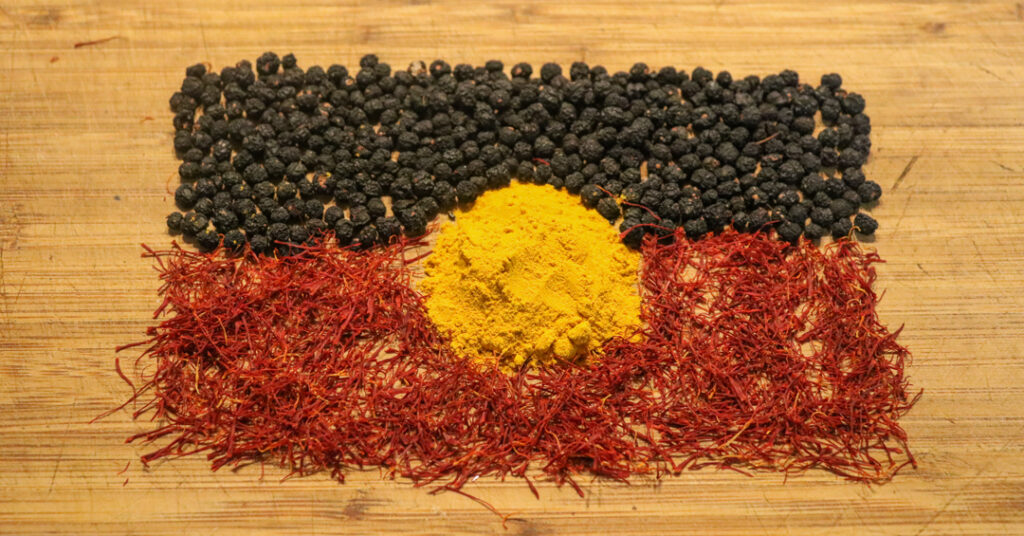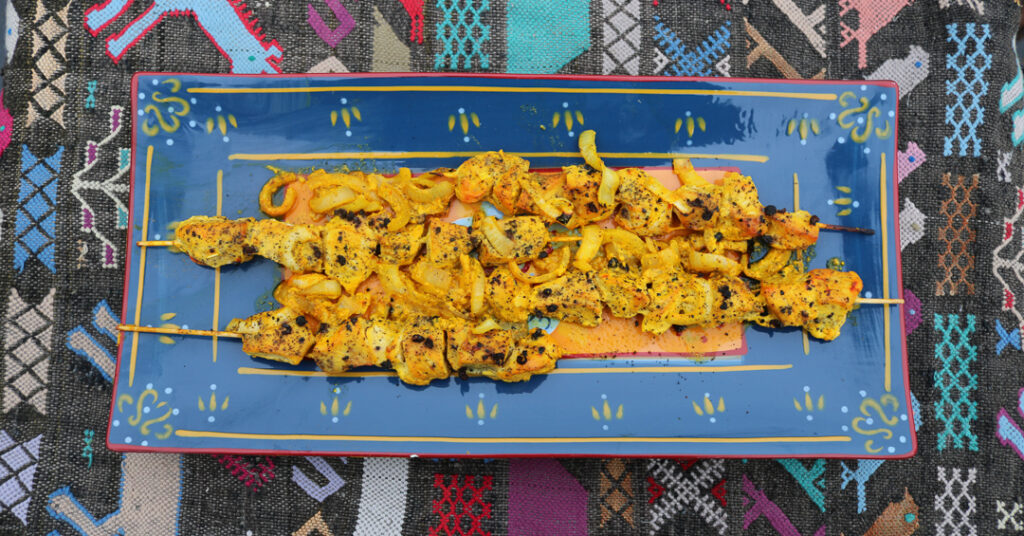
Jahan Rezakhanlou deconstructs the idea of “authenticity” in Iranian cuisine by experimenting with Indigenous Australian ingredients in Melbourne-Naarm, straying away from either tokenistic fusion labels or the home-grown demands of “authentic” foreign food in the West.
In her seminal cookbook Honar-e Ashpazi (‘the Art of Cookery’), widely considered the quintessential Iranian cookbook of the twentieth century, the famed Iranian chef Roza Montazami dedicated a chapter to Iranians living aboard. In this section, Montazami detailed how to cook certain Iranian foods when certain typical Iranian ingredients or tools were not available. For instance, she describes cooking kebabs in a frying pan rather than with the traditional metal seekh (skewer) over an open flame. Such techniques would be considered “inauthentic” by many modern standards, yet it firmly places itself as distinctly “Iranian cuisine” by none other than Roza Montazami. To reduce a cuisine to a process of historical “folkloric” reconstruction, rather than conveying its spirit and its appeal to the senses, is surely to deny it its essence.
Yet within sections of Western food culture, the very thought of Iranian and other migrant cuisines compromising their “authenticity” to their new environments is culinary sacrilege. In today’s globalized world, it is much easier to access a vast array of Iranian ingredients and tools (at least those that succeed in bypassing economic sanctions). Thus it is eminently possible to emulate the authentic Iranian manner as close as possible when in Australia, and this offers a way for all to access and interact with the culture even if separated by thousands of kilometres. Yet to confine ourselves to a “quest” for home-grown authenticity seems unduly limiting for a living culinary tradition, even to the point of feeling somewhat inauthentic in Australia, given the incredibly rich yet unexplored set of cooking traditions through a vast array of indigenous cultures and food ingredients that have sadly gone under the culinary radar in the rich food culture of the country. Upholding an ostiary sense of authenticity in a sense kills the natural inquisitiveness of Iranian cuisine, and indeed betrays the legitimacy of adaptation that is so clearly recognised in the “bible” of modern Iranian cuisine.
In Australia, indigenous ingredients are starting to make a mark. Indigenous-owned culinary institutions such as Mabu Mabu in Melbourne-Naarm or Wildflower in Perth-Boorloo and even Kettle Chips’ “Native Flavour Collection” featuring such flavours as Lemon Myrtle Chicken have helped usher in an increased awareness of indigenous ingredients and culinary traditions. However, so far this has been an extension of the “modern Australian” tag through crafted modern Western menus incorporating indigenous ingredients. Thus it is time for the likes of Iranian cuisine—and indeed other recent migrant cuisines that are so widely consumed in Australia today—to properly experiment and incorporate the indigenous Australian tastes into our cuisines, as a means of building cultural bridges with those whose land we live on and of course to deepen our understandings of our own cuisines and palates.
Thus, in the spirit of Roza Montazami, where one can cook Iranian food without the long list of “authentic” ingredients and tools to cook Iranian cuisine, I have imagined a lost chapter of the Honar-e Ashpazi dedicated to Iranians in Australia such as myself who can cook Iranian food with specifically Indigenous Australian ingredients. Although it may not be out of material necessity, it is still a cultural and spiritual one to explore the untapped potential of mixing indigenous Australian ingredients with Iranian cuisine. I am not a formally trained or professional chef, yet through a series of culinary experiments, I have set out to write and self-publish a series of recipes of Iranian and Central Asian cuisine that incorporate Indigenous Australian ingredients. The aim is to record and share my discoveries, as well as to encourage others to incorporate Indigenous ingredients into their cooking, not just as an ingredient for “Modern Australian cuisine” but also as a way of probing the esoteric boundaries of “authenticity” when it comes to the non-Western cuisine that is so popular in Australia.
Iranian cuisine is one that relies on herbs, thus using the wide array of indigenous herbs was the first step I took in mixing the two palettes. So far in my experience, most indigenous Australian ingredients are often been named after typical kitchen ingredients they share properties with that most people would be familiar with, such as lemon myrtle, cinnamon myrtle, strawberry gum, pepper berry and saltbush. Whilst this may not be an ideal manner in which to learn about the cultural significance of these indigenous ingredients to the indigenous people of Australia, it does help make it easy to organically incorporate these new flavours into Iranian cuisine, which like most other cuisines where we can think about the process of incorporating Indigenous ingredients as a series of regional substitutes.
For instance, due to the heavy reliance on sour citrus tastes (through lime juice or dried lemons) within savoury dishes in Iranian cuisine (typically through preserved lemons or strong lime juice) lemon myrtle provides a great way to re-invent and explore the “citrus” taste so dominant in Iranian cuisine. In my own experiments, lemon myrtle has given a milder, yet longer-lasting citrus taste that has given dishes like Joojeh Kabab (Saffron Chicken Kebab) a flavour with more depth and subtlety.
Naturally, the best way to learn most things in the culinary world is to directly experience the cooking and tasting process. Thus here is a sneak-peak recipe from the zine, which is a new version of one of the staples of Iranian cuisine, Saffron Chicken Kabab, that has been given a distinctive Indigenous Australian flair.
Bush Joojeh Kabab

Ingredients for the Kabab:
500 grams of Boneless Chicken Breasts or Thighs
2 Tablespoons of plain yogurt
1 Small onion
5 or 6 Saltbush leaves
5 Tablespoons of lemon myrtle powder
3 Tablespoons of ground pepperberries
100 mg of ground saffron
Ingredients For the Sauce:
100 grams of purslane
3 Tablespoons of yogurt
1 Tablespoon of lemon myrtle powder
2 Lebanese cucumbers
1 Tablespoon of olive oil
For the chicken:
- Trim all the fat from the chicken and dice into approximately 2cm cubes.
- Add half a cup of boiling hot water to the ground saffron powder, add the mixture to the chicken. Leave to marinate for at least 20 minutes.
- Slice and add the onions, now add the yogurt, saltbush leaves, lemon myrtle powder, ground pepperberries to the chicken and stir.
- Marinate and refrigerate for at least 4 hours (you can prepare the sauce meanwhile.)
- If grilling over an open flame, put the chicken pieces through a set of skewers (preferably metal) and cook over a medium-high flame until softly charred. Sprinkle leftover lemon myrtle powder whilst cooking.
- If roasting in the oven, preheat the oven to 200C and cook the chicken pieces in a tray for approximately 20-25 minutes, flipping them halfway through.
For the sauce:
- Slice the cucumbers into quarters and remove the excess water.
- Crush the garlic gloves.
- Slice and wash the purslane leaves, remove the stems depending on how crunchy you like the sauce.
- Mix all the ingredients together to create the sauce.
Indigenous Australian foods
About Jahan Rezakhanlou
 Jahan Rezakhanlou is a Swiss-Iranian multidisciplinary artist, musician and journalist currently undertaking his Master of fine arts at RMIT in Melbourne-Naarm, Australia. His research and practice focus on identifying urban and cultural structures and their impacts upon society, having worked with Iranian, Swiss, Hong Kong and Japanese grassroots art collectives both internationally and within Australia. For his Masters, he is examining different egregores within migrant communities in Melbourne-Naarm and how they are sculpted by the urban environment. Follow haikyo_e.jahan
Jahan Rezakhanlou is a Swiss-Iranian multidisciplinary artist, musician and journalist currently undertaking his Master of fine arts at RMIT in Melbourne-Naarm, Australia. His research and practice focus on identifying urban and cultural structures and their impacts upon society, having worked with Iranian, Swiss, Hong Kong and Japanese grassroots art collectives both internationally and within Australia. For his Masters, he is examining different egregores within migrant communities in Melbourne-Naarm and how they are sculpted by the urban environment. Follow haikyo_e.jahan

